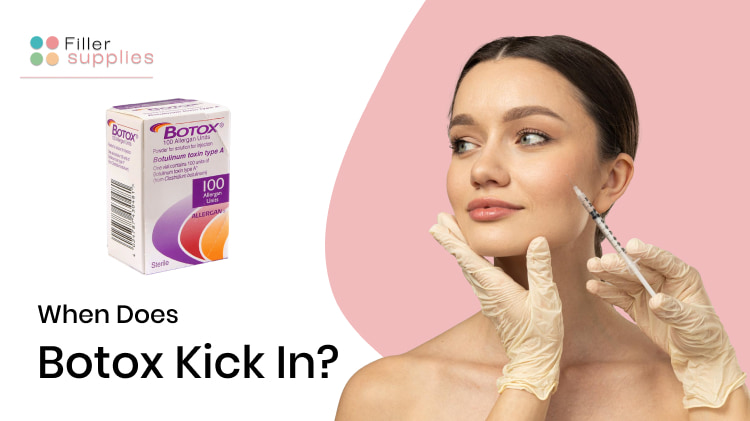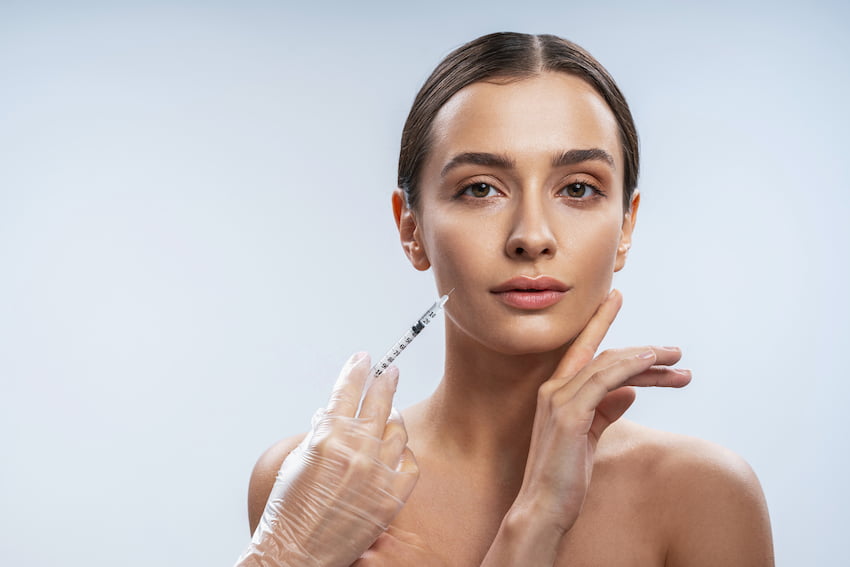When Does Botox Kick In?

Are you considering Botox injections to achieve a more youthful appearance and radiant look? This FDA-approved cosmetic treatment helps millions worldwide restore smooth skin and reduce wrinkles such as glabellar lines, crow’s feet, or forehead lines. Join us as we uncover the nuances of Botox, answering burning questions like when it starts working, how long it lasts, and how to prolong its results. Keep reading to get all the information.
How Does Botox Work?
Botox is short for botulinum toxin. It’s a neuromodulator. Botox works by temporarily paralyzing or relaxing specific facial muscles, which in turn softens or eliminates fine lines and wrinkles.
When injected, Botox travels to the nerve endings near treated areas. It blocks the release of acetylcholine, a neurotransmitter responsible for muscle contractions. This way, Botox injections prevent the muscles from contracting excessively. Thus, it reduces the appearance of wrinkles formed by repetitive facial expressions.
The specificity of Botox is noteworthy. It doesn’t induce a blanket inhibition of nerve signals but selectively interferes with the nerves associated with muscle movement. This precision is a key factor in achieving natural-looking results. It allows the retention of facial expressiveness while mitigating the signs of aging.
A side note: Looking for Botox supplies for your clinic? FillerSupplies is dedicated to helping healthcare professionals by offering a diverse range of injectables at budget-friendly prices. Buy Botox online and stay ahead in the competitive field of aesthetic medicine!
Who Is an Ideal Candidate for Botox Injections?
A thorough health assessment with a qualified professional ensures suitability for Botox treatment. Candidates for this treatment typically wish to address glabellar lines, crow’s feet, or forehead lines. Botulinum toxins are effective in treating these dynamic wrinkles. Since Botox may require a few treatments for maximum effect, ideal candidates are open to follow-up sessions.
Generally healthy individuals without underlying health conditions. Those with allergies to botulinum toxins, neurological disorders, or skin infections are not recommended to have Botox injections. Pregnant or breastfeeding women are typically advised to avoid Botox injections due to limited research on its effects during these periods.
How Long Does It Take for Botox to Work?
The timeline when Botox takes effect is not immediate. Some individuals may experience noticeable changes within a few days after the first treatment. The typical duration for noticeable results is between three and five days. This period allows botulinum toxins to bind nerve endings, blocking the signals that cause muscle movements and wrinkles.
Although patients may begin to see initial changes within days, the full effect of Botox takes up to two weeks to manifest. When botulinum toxins are injected, the targeted muscles gradually relax for a few weeks, smoothing out lines and wrinkles.
Why Does Botox Take Time to Work?
Botox’s primary mechanism of action involves blocking the signaling chemicals from nerve fibers. This pivotal action interrupts the typical communication between nerves and muscles, preventing contraction. Botox works as a molecular barrier, halting the messages. It takes time to spread botulinum toxins, interact with specific muscles, and paralyze their signals. This process typically takes at least one week. When Botox kicks in, most people notice smoother texture and skin rejuvenation in the treated area.
The answer to “How long does Botox take to work?” will be not full without an overview of influencing factors:
- binding sites: the nerves affected by Botox have binding sites. The abundance of these sites dictates the speed of results. More binding sites equate to a quicker onset.
- dosage and area treated: The finer the lines — the quicker the results. Thus, a lower dosage is needed. More severe lines may require higher dosage or additional sessions for desired outcomes.
- individual response: each person’s body reacts uniquely to Botox injections. Factors like metabolism and the strength of facial muscles can influence the time it takes for Botox to exhibit maximum results.
How Long Does Botox Last After the Treatment?
Despite the initial efficacy of these cosmetic treatments, the protein in Botox is not a permanent fixture in the treated areas. The body initiates a breakdown process over time, gradually metabolizing and eliminating the Botox protein. Each person’s body responds uniquely to Botox treatments, resulting in personalized timelines for its breakdown.
The timing varies among individuals. Generally, Botox results endure three to six months after the last treatment. Individuals may experience a gradual return of muscle function over time, leading to the reappearance of dynamic lines.
The location of the injection matters. Areas with finer muscles, such as crow’s feet, may show quicker and more noticeable results compared to larger muscle groups. Also, the type and depth of wrinkles in specific regions influence how long does it take for Botox to work and last.
The follow-up appointment assists in maintaining sustainable results. Subsequent treatments help address changes in muscle response, adding Botox if needed to improve the treated area.
In summary, the duration of the effects depends on individual metabolism, dosage, injection technique, muscle activity, treatment area, skin types, lifestyle, and other factors.
What Areas Are Treated with Botox?
When the treatment is injected, it primarily targets areas prone to dynamic wrinkles caused by muscle movement. Here are the most common areas for Botox treatment:
- forehead;
- glabella (between the eyebrows) and brow;
- under the eyes;
- around the mount and nose (bunny lines, smile lines, nasolabial folds);
- chin and jawline;
- neck.
Beyond cosmetic applications, Botox is used for medical purposes. It’s an FDA-approved treatment for cervical dystonia, muscle stiffness, chronic migraine, or hyperdoses (excessive sweating). As ongoing research explores new avenues for Botox applications, its medical uses continue to expand.
How Long May Side Effects of Botox Treatment Last?
The side effects of Botox treatment are generally mild and temporary. Most of them resolve within a few days to several weeks. Common side effects include bruising, swelling, or redness at the injection site. Headaches or flu-like symptoms may occur but tend to subside quickly.
If preparing for a special occasion, it’s advisable to get injections at least two weeks before the event. In some cases, patients need time to reduce swelling, redness, or any other body’s response to Botox treatment.
Serious side effects are rare but may include difficulty breathing, swallowing, or speaking, muscle weakness, and vision problems. Seeking immediate medical attention is essential.
Patients may experience side effects for a longer duration, but this is less common. Follow post-treatment care instructions provided by your healthcare provider to minimize the risk of prolonged side effects.
How to Prolong the Botox Results?
Understanding how long it takes for Botox to work and the duration of its effects can guide you in maintaining an enhanced appearance. To prolong the results of the treatment, patients should:
- minimize sun exposure: it can expedite the breakdown of Botox;
- use sunscreen regularly, especially in the targeted areas;
- avoid harsh skin care products;
- be gentle with your skincare routine;
- limit smoking and drinking alcohol;
- adopt a healthy lifestyle;
- drink enough water to support the healing process;
- use moisturizing creams.
By incorporating these practices into the aftercare routine, patients extend the time between treatments and enjoy benefits longer.
Conclusion
The journey to a youthful appearance involves patience, proper care, and collaboration with a skilled healthcare professional. As we’ve explored, the question “How long does Botox take to work?”, it typically takes a few days to get visible effects and several weeks to achieve the maximum results. Choosing an experienced and qualified practitioner for Botox injection ensures precision and optimal placement of the substance, contributing to enhanced effectiveness and prolonged results.

